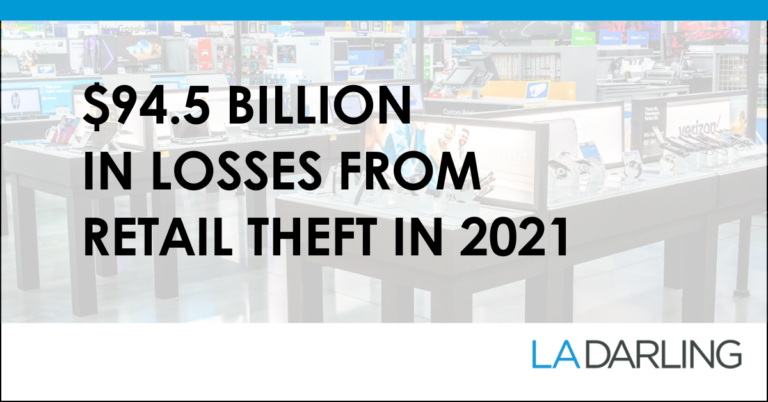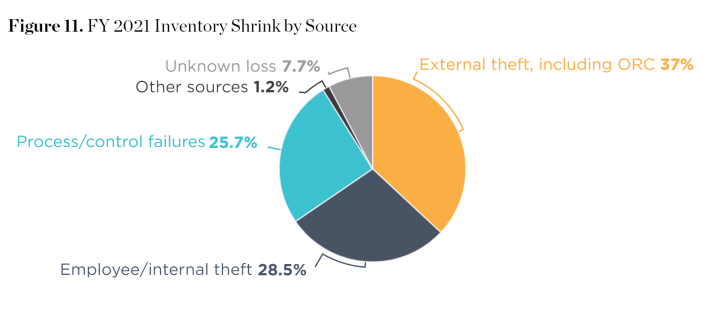When merchandise walks out the door without being paid for, it’s referred to as shrink by retailers. This hits retailer’s bottom line, but shrink also has significant impacts on people, both in terms of safety and economic fallout.
To establish some perspective of the size of the problem, in 2021, retail shrink losses in the U.S. amounted to $94.5 billion, or an average of 1.4% of total retail sales.
On the human, socio-economic side, it’s also responsible for 658,375 lost jobs and almost $39.3 billion lost in wages and benefits to workers. And beyond the numbers, it’s damaged employees’ mental health and resulted in serious trauma and death.
Let’s take a closer look at shrink — what’s causing it, who it affects, and what we can do to stop it.
What is retail shrink?
Retail shrink is the term often used to refer to the preventable losses experienced by a retailer, caused by human error or intentional efforts. In its simplest terms, shrink is a loss in retail inventory—goods not purchased but taken from a store.
Various methods can be used to calculate exact numbers, but in general, it can be viewed as:
Retail Shrink Rate = (retail shrink value) / (optimal retail value of products)
What are the causes of retail shrink?
The causes of retail shrink fall into broad categories:
- External Theft
- Internal/Employee Theft
- Administrative Errors—human errors in ticketing or transactions, point of sale errors
- Fraud and other sources of loss
Operational loss refers to expired goods, breakage or damage that prevents sale and this category of loss is generally considered a cost of doing business. On the other hand, according to the 2022 National Retail Security Survey, 37% of retail shrink can be attributed to external theft, a category that includes both shoplifting and organized retail crime.
A closer look at external theft
Shoplifting refers to merchandise theft from a shop floor during the hours of business operation. Arizona State University Center for Problem-Oriented Policing notes that typically, offenders fall into one of three groups:
- Opportunistic thieves/petty shoplifters, stealing for their own use or opportunistically
- Determined thieves, operating alone and stealing small quantities of goods to resell
- Organized thieves/groups of professionals, stealing larger quantities of goods for resale
In the United States, the most common stolen items or “hot products” can be described as having one or more of the attributes that make up the acronym, CRAVED, which stands for:
- Concealable
- Removable
- Available
- Valuable
- Enjoyable
- Disposable
More specifically, according to the 2022 National Retail Security Survey, the most widely stolen goods fall into the categories of apparel, electronics, health and beauty, accessories, footwear, home furnishings, home improvement, office supplies, food and beverage, children’s items, and other.
Several commonly used shoplifting techniques involve:
- Concealment or hiding goods in loose clothing or a bag
- Using box devices or specially designed “booster” bags
- Palming, substituting, and switching
- Taking and walking out, employing a bold, quick, snatch and grab
Rising rates of organized retail crime (ORC)
Increasingly, snatch and grab thefts are becoming more bold and are involving more violence. These methods are most often applied by professionals involved in organized retail crime (ORC).
Buy Safe America defines organized retail crime as professional shoplifting or other theft occurring in retail stores. These crime rings use a variety of marketplaces online and otherwise to quickly move stolen goods. Rates of ORC have increased by 26.5% in 2021, says the 2022 NRSS.
Policies of retail organizations vary, but frequently employees are being advised against pursuing shoplifters; store associates are more often at risk of injury in these thefts.
The human cost of shoplifting
While sometimes thought of as a “victimless crime” or an entry point to more serious criminal activities, shoplifting can have potentially fatal effects.
Recent new stories tell of store associates being killed while trying to stop shoplifters. A California Rite Aid employee was shot and killed in 2021 trying to stop a shoplifter from leaving the store. In North Carolina, in 2022, a Home Depot employee died of injuries sustained when he was knocked to the ground by a shoplifter leaving the store with three power washers.
Not only store employees are endangered by the actions of fleeing shoplifters. A woman in West Virginia sustained significant traumatic internal injuries when a fleeing shoplifter collided with her in the store, knocking her to the ground and toppling her cart onto her.
Mental distress is another factor. A report for the Retail Industry Leaders Association and Buy Safe America Coalition, found that
- 86% of retailers surveyed said an ORC subject has verbally threatened an associate
- 75.9% said an ORC subject has physically assaulted an associate
- 41% said an ORC subject has used a weapon to harm an associate.
Workers who have experienced violence of this type may experience emotional and psychological effects such as fear, anger, and symptoms of post traumatic stress disorder.
The economic cost of external theft
Shoplifting is sometimes thought of as a victimless crime; that attitude is changing, not only because of the increasing violence but because of the magnitude of economic damage that results.

Retail theft in the U.S. amounted to $94.5 billion in losses in 2021 or an average of 1.4% of retail sales. While that percentage alone may not strike fear in your heart, it does have repercussions. Losses mean retailers face increased costs—the cost of the goods, security, and labor.
As retail costs increase, the cost to consumers also rises. With rising prices, sales diminish. A downturn in sales leads to a reduction in jobs throughout the economy. Based on a report from RILA considering the impact of retail theft in 2021, losses include:
- $125.7 billion in lost economic activity
- 658,375 lost jobs
- almost $39.3 billion loss in wages and benefits to workers.
Further affecting communities and retailers, when crime rates in a location rise, store locations may close, creating a ripple effect, eliminating jobs and reducing access to goods within that area.
Shoplifting became so significant that a prominent Nike factory store location, first opened in 1984, has temporarily closed because of theft. The company is working with the city of Portland to create a solution so that the store can reopen.
What can be done to mitigate the risks?
On macro-level, recent legislation, the INFORM Consumers Act, has been passed that will increase transparency and accountability in online marketplace transactions. The law will take effect in June 2023.
Its goal is to make it more difficult for sophisticated crime rings to hide behind anonymous online transactions. Michael Hanson, RILA senior executive vice president, public affairs, stresses the importance of collaboration in the efforts to enable the prosecution and break-up of criminal rings that target retail.
We’re glad to see that government is acting on the problem, but what can retailers do? Here are a few suggestions:
Tighter stock controls. Technology and detection devices as well as various tag systems can help deter theft. Many different systems and specialty tags are available to protect a wide range of goods.
Upgraded security practices. Implementing greater structure into routine practices, such as sealing bags after purchases, clear rules for fitting rooms with increased supervision, and checking receipts as customers exit the store are measures that can help reduce shoplifting.
More secure retail displays. Within the retail environment, collaborative and innovative design of security showcases is another way that retailers have reduced theft while also improving the shopping experience for customers.
Improved security displays help thwart those attempting smash and grab thefts. When a case can withstand greater impact, store employees have extra minutes to alert and summon professional security protection. Custom security case designs give retailers more control over their merchandise and the shopping experience.
Retail shrink is a multifaceted problem. Retailers, customers, employees, and communities are affected. Effectively deterring external theft would go a long way toward diminishing shrink and helping retailers protect the shopping experience for customers.
